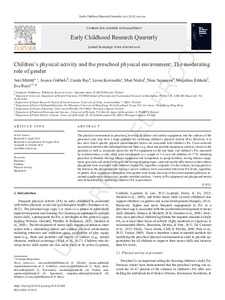Children's physical activity and the preschool physical environment: The moderating role of gender
Eva Roos; Suvi määttä; Nina Sajaniemi; Leena Koivusilta; Carola Ray; Maijaliisa Erkkola; Jessica Gubbels; Mari Nislin
https://urn.fi/URN:NBN:fi-fe2021042826820
Tiivistelmä
The physical environment in preschool, covering all indoor and outdoor equipment, and the surfaces of the preschool yard, may have a large potential for increasing children's physical activity (PA). However, it is less clear which specific physical environmental factors are associated with children's PA. Cross-sectional associations between the individual observed items (e.g. fixed and portable equipment, surfaces, terrain in the grounds) as well as composite scores for the PA equipment on the one hand, and children's PA, measured by accelerometers, on the other, were investigated in a sample of 3-6 year old children (N = 778) attending preschool in Finland. Having balance equipment and trampolines in group facilities, having balance equipment, gym mats and sticks in the gym and having skipping ropes, sand and mostly hilly terrain on the outdoor playground were associated with children's higher PA, regardless of gender. On the contrary, having gravel as the terrain in the playground and having a seesaw outdoors were associated with lower PA levels, regardless of gender. Four significant interactions with gender were found, but none of the environmental predictors remained significant in the post-hoc gender-stratified analyses. Variety in PA equipment and playground terrain may be beneficial for increasing children's PA in preschools.
Kokoelmat
- Rinnakkaistallenteet [19206]
